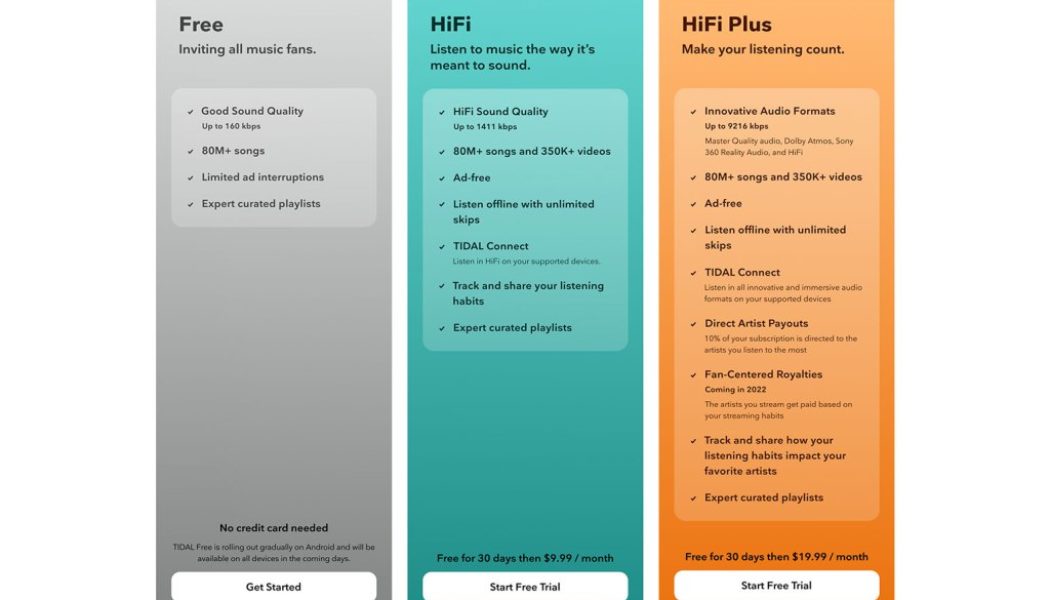Tidal is launching a free tier in the U.S. and is introducing a user-centric payment model for its premium subscription offerings, the company announced Wednesday (Nov. 16). The moves mark the first major shifts under its new parent company Square, which acquired Tidal earlier this year for $302 million.
The streaming service now has three tiers for listeners to choose from: Tidal Free, which gives U.S.-based listeners free access to Tidal’s 80 million song catalog; Tidal HiFi, which offers high-fidelity audio and offline listening with a new feature called My Activity that will provide daily listening insights for listeners for $9.99 a month; and Tidal HiFi Plus, a $19.99 a month subscription that includes immersive sound options like Dolby Atmos Music and Sony 360 Audio and Master Quality Authenticated MQA tracks, along with early access to exclusive offerings and upcoming features.
The Tidal HiFi Plus tier is where the revenue for direct-to-artist payouts and Tidal’s fan-centered royalties will come from. Instead of using the current pro-rata system, which pays rights holders based on their share of total streams, fan-centered royalties will be paid based on the streaming activity of each individual HiFi Plus subscriber. In addition to the new payment structure, Tidal says 10% of the subscription fee from HiFi Plus users will go to their most listened to artist that month (directly into their Cash App account in the U.S., or their PayPal account globally) in addition to their normal streaming royalties. Listeners will be able to track who their top artists are every month through the My Activity feature.
Trending on Billboard
“For the new artist features we focused on two big ideas,” Jesse Dorogusker, head of Tidal, tells Billboard. “The first is transparency, making sure there’s a direct connection between fans listening and their favorite artists. That means showing the data, and that means taking action on it. The second big idea is to create new revenue opportunities for artists. And these features are just the first steps in this direction.”
Tidal says artists must opt-in to access direct artist payouts. Currently, the program is invite-only, but Tidal says it will continue to increase access over the coming months, and it is partnering with distributors including DistroKid, TuneCore, Stem, CD Baby and Symphonic to allow artists on those platforms to register and receive payments through their respective distributors.
“We’ve been working with all the labels big and small to move toward fan-centered royalties,” Dorogusker says. “If it were a slam dunk that this got all artists paid more I think it would have been universally adopted and certainly easy for us to evangelize since we’ve always been at the front of paying artists the most. If you remember back in the day of buying a CD, if I bought a CD and you bought a CD, those were two CD sales — no one knew or cared how much each of us loved that CD or listened to it or never listened to it. And then the introduction of streaming just evolved into what was easiest to measure 10 years ago, which is just count up the streams. It’s probably a swing of the pendulum too far in the other direction and it doesn’t really value adding new people to the platform. It’s indifferent between one person with 1,000 streams and 10 people with 100 streams.
“I think if you’re trying to build a rich ecosystem of fans and artists, you prefer, of course, more customers to fewer customers. Fan-centered royalties just shines a brighter light on what it means to bring new people to the platform and how their behavior tied for royalties, and we’re really excited to promote that conversation.”
Tidal is the second prominent streaming service to introduce a user-centric streaming model, following SoundCloud’s rollout of its fan-powered royalties for indie acts back in March. “We know others have experimented with [user-centric] in the market, but it’s really hasn’t been done on a large scale,” says Lior Tibon, Tidal COO. “So this is really the first time to our knowledge that any service is launching this with well over 100 partners — major labels, independent labels and distributors.”
As for the free tier, Tidal will not be introducing ads for listeners just yet, but will “interrupt” them with prompts to upgrade to a paid tier and offer a more limited experience, with less access to on-demand content, and no access features including lyrics, offline downloads and lower audio quality. “It’s something that’s going to come from our own operating budget,” Tibon says when asked how Tidal will pay artists for streams on Tidal Free without ad revenue. “We’re going to assess as we move forward in terms of the different behavioral aspects and other considerations, whether we want to introduce any type of monetization later on.”
Tidal’s changes are fundamental shifts in the streaming ecosystem that haven’t been accomplished yet at this scale. Square’s goal of putting more money into the pockets of artists and rights holders quickly seems to be in reach, and now the question shifts to whether Tidal will be able to attract the audience that will make those dollars meaningful to the majority of artists.
With two notable streaming services in SoundCloud and Tidal switching in part to user-centric payment models and Tidal paying artists a portion of their subscription revenue directly every month, the prominent ideas around how to improve the streaming ecosystem for rights holders are no longer theoretical, soon there will be data to prove whether the status quo needs to change.










